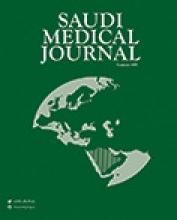Abstract
OBJECTIVE: To determine the predisposing factors and to evaluate the role of laparoscopy in the diagnosis and management of primary omental torsion in children.
METHODS: We retrospectively reviewed the clinical records of all children treated for primary omental torsion from August 1999 to December 2004 at King Khalid University Hospital, Riyadh, Saudi Arabia. Demographic data, clinical presentation, diagnostic and therapeutic modalities were evaluated. Follow-up was also obtained.
RESULTS: Six children were included in the study. Their age ranging between 9-12 years (average 10.4 years). All of them presented with right lower quadrant (RLQ) pain mimicking appendicitis. The duration of symptoms varied from 3-5 days prior to presentation. Localized RLQ tenderness with guarding was demonstrated in all patients. All children were noted to be obese. Only one patient had low grade fever and nausea. None of the patients had an elevated white blood cell count. Laparoscopic exploration was carried out in all cases for possible appendicitis. Appendix was found to be normal and torted omentum was clearly seen in all cases. The infarcted omentum was removed laparoscopically; all patients had uneventful recovery and were discharged on second postoperative day. Pathological examination showed necrotic infarcted omentum with no other abnormalities. Follow-up documented complete resolution of the patient's symptoms.
CONCLUSION: Clinical presentation of primary omental torsion mimics that of acute appendicitis. Its diagnosis is usually difficult and almost impossible pre-operatively. Obesity, paucity of gastrointestinal symptoms and relatively long duration of symptoms should increase the index of suspicion. We believe that the laparoscopic approach is an excellent tool for the diagnosis and treatment for the primary omental torsion.
- Copyright: © Saudi Medical Journal
This is an open-access article distributed under the terms of the Creative Commons Attribution-Noncommercial-Share Alike 3.0 Unported, which permits unrestricted use, distribution, and reproduction in any medium, provided the original work is properly cited.






